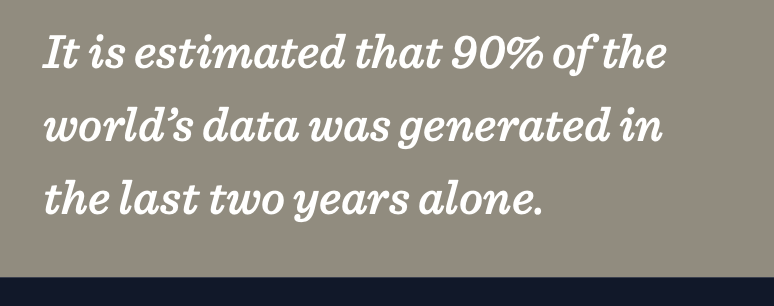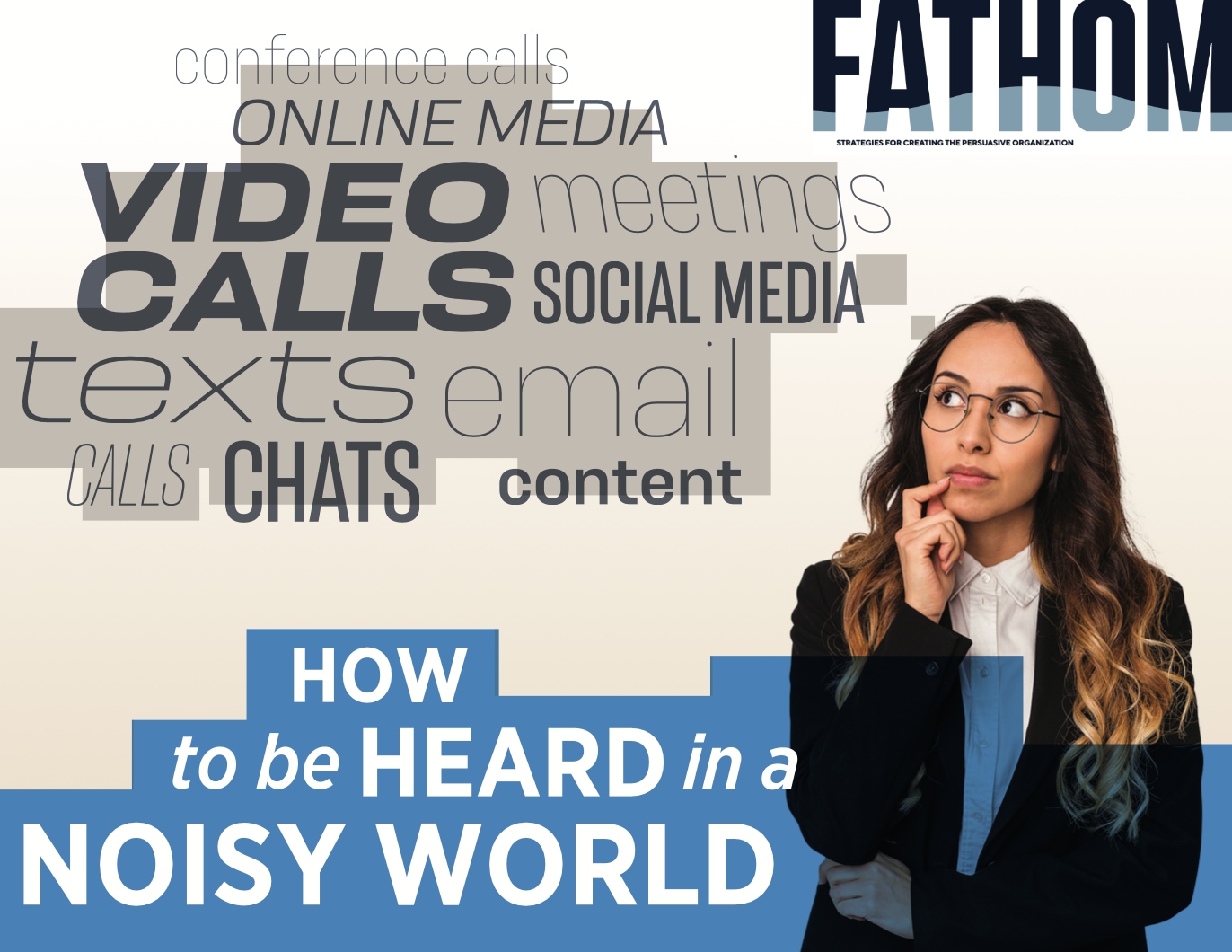Read this issue in its original magazine format.
Strategies for Creating the Persuasive Organization
The world is noisy and getting noisier by the day. The amount of information available — through email, texts, chats, video calls, meetings, online media, and more — can be overwhelming, disorienting, and is almost always distracting. Good information becomes difficult to separate from bad. And in a business context, all this noise makes it harder to be heard causing good ideas to be ignored, important decisions to be delayed, and decreasing employee morale.
Companies that want to compete and thrive need to find strategies to diminish the distraction. Leaders need to develop structures and practices, for themselves and their teams, that allow for focus, efficiency, and ultimately more powerful communication. And they need to cultivate the skills and practices that allow everyone in the organization to communication more effectively.

Rather than thinking solely about organizational structure — who reports to whom — leaders should also consider establishing three things, in order to meet the challenges of this noisy world:
1. Communication structure, the deliberate determination of how information flows through the organization.
2. Communication norms, delineating expected practices and protocols across the organization, for everything from direct messages to meetings, from informal phone calls to formal presentations.
3. Communication behaviors, through training and consistent feedback, allowing each member of the team to practice and improve their own communication.
All together, these choices form a communication culture — an intentional framework for managing the noise and cutting through it.
How noisy is it?
According to the trend analysis firm Exploding Topics,1 each day approximately 402.74 million terabytes of data are created, and in 2024, around 147 zettabytes of data will be generated. (To put this in perspective: one zezzabyte equals one trillion gigabytes.)
And the rate of digital content creation is increasing exponentially: it is estimated that 90% of the world’s data was generated in the last two years alone.
These enormous data streams are costly and overwhelming: according to the Information Overload Research Group,2 skilled workers waste up to a quarter of their workday managing this deluge, at a cost of $990 billion per year. And there is an unquantifiable cost in cognitive overload. We hear about this every day from all clients of The Latimer Group — impossible to quantify, but undeniable in existence.
The cognitive overload doesn’t just come from the volume being produced; it also emerges from the associated work employees and leaders must do to manage and process information — especially from internal company communications. In a survey of 1,000 employees and managers, the consulting firm Gartner3 found that what they call “information burden” results in communications that are duplicative, irrelevant, effort intensive, and/or inconsistent.
As the Gartner researchers explain in The Harvard Business Review, this burden is particularly acute for those leading teams or organizations: “Our research shows that 40% of leaders and 30% of managers report high levels of burden. This is not to be taken lightly: Those that report high burden are 7.4 times more likely to report high ‘decision regret,’ and 2.6 times more likely to have avoidant or negative responses to change.”

This research is highly consistent with our own. Over the last seven years, The Latimer Group has surveyed nearly 10,000 workshop participants; on average, those participants tell us that approximately 30% of their time is wasted on a weekly basis managing information overload.
With no signs of this information stream slowing down, what can a leader do to help ease the burden for the entire organization and ensure that necessary information doesn’t get lost? The answers to these questions are clear: by setting better communication structures, norms, and behaviors and creating an intentional communication culture.
Intentional Communication Culture
Every business has a communication culture — who communicates to whom, how they do it, when they do it, and why. But it is important to approach this culture not as simply a byproduct of organizational structure or the exigencies of the moment, but to develop it with intention, bolster it with training and skill-building, and to model it from the top down. To achieve a strong communication culture, you need to define the Who, When, Why, and How.
Intentional leaders must define three components:
- Structure: who communicates with whom
- Norms: when and why we communicate
- Behaviors: how we communicate
The first two require leaders to set out clear expectations and ways for teams to communicate effectively and productively. The last offers ways for individuals — from the C-suite down — to cut through the noise and have their own message be heard.
Structure: Lines of Communication
A functional communication culture starts with setting up the correct lines of communication, so that each member of the team receives the right information from the right person. It is important to create a strong structure even for small teams — especially because as teams grow, the potential complexity of the communication structure increases exponentially, as illustrated in the graphic to the right.
One of the key challenges in setting out a strong communication structure is balancing a desire for transparency with a need for targeted, efficient communications — so that everyone knows what they need to know, without being overwhelmed by extraneous information. As one McKinsey report found, “many people do not want to know the full details of how their firm is doing, nor do they want to be held fully responsible for its outputs. Instead, they want to know enough to do their job well and they want to have the right to know more, but for the most part they are happy for someone else to process and manage that information on their behalf.”4

Leaders need to set up structures for information sharing that take into account how information cascades through the organization, understanding who needs to know what and when — and then clearly communicate the roles and expectations for information sharing to each member of the organization.
Creating an effective internal communication structure will also impact the efficacy of an organization’s external communication. After all, the same practices that underpin internal communication practices — clarity and concision, understanding one’s audience and their needs — underpin external communications as well.
Norms: Setting Expectations
Along with communication structures, businesses should set out a comprehensive set of norms for how information travels across their organization. This includes expectations of use and practice for different channels, and meeting guidance and expectations. As McKinsey5, 6 analysts have observed, managing information “requires a tremendous amount of self- discipline” — and establishing norms creates metrics and accountability for all members of the team, including leadership.
At The Latimer Group, our own team has developed a set of protocols and norms that guide how we approach our own internal communications. These practices emphasize maintaining clear and consistent communication to boost connection and productivity. They set out an expectation that, after regular business hours, team members use appropriate communication channels (such as using email for non-time-sensitive messages). Finally, our protocols offer guidance for choosing the appropriate communication channels, such as email, chat, video conferencing, phone calls, or text, based on the context and needs.
Of course, there is one culprit commonly cited as contributing the most to information overload: meetings. All too often, many scheduled meetings feel extraneous, include more participants than necessary, and/or are padded with information that could just as easily have been sent in a brief email.
Creating an efficient meeting culture is essential. Setting clear parameters for what needs to happen before, during, and after a meeting can both help safeguard against information fatigue for participants, and help meeting organizers make sure that their audience can understand and absorb their message. Leaders should think, “If my direct report is in meetings for 6 hours a day, how much can they really be getting done in the remainder of the time?”
Before a meeting, establish a clear request outlining what needs to be addressed, who will be involved, how it will be conducted, and when it will take place. Create a detailed agenda that includes the topic, timeframe, and expectations of the audience, to ensure everyone understands the sequence of events and prepare a Plan B for contingencies that might arise.
Start by asking three key questions:
- Is the meeting necessary? Evaluate if the time spent could be better used elsewhere and the information conveyed through email.
- What is the goal of the meeting? Define a clear, direct agenda and communicate it to all attendees beforehand.
- Who needs to be there? Invite only those who will actively contribute to the discussion.
During the meeting, focus on managing technology, ensuring all necessary participants are present, setting and managing expectations, fostering engagement, and concluding the meeting effectively.
Post-meeting, follow up to reinforce decisions and actions; capture notes and meeting minutes in a known location. Additionally, leadership should set a “meeting budget” to limit time spent on meetings and use frameworks for responsibility to manage participation and duration. Or, as McKinsey7 puts it, make meetings a “scarce resource” — time that is valued for collaboration and discussion, rather than dreaded.

Behaviors: Cutting Through the Noise
Improving communication within an organization requires that everyone, including leadership, take clear, effective steps that enhance their communication — because leaders are fighting to be heard, too.
When the world is noisy, it takes deliberate effort to make yourself heard — and turning up the volume isn’t the solution. The good news is that the skills necessary to be heard can be learned, and are not innate — they can be practiced and honed. With training, nearly anyone can learn to get to the point quickly and clearly, present synthesized information, and make it easy for people around them to hear, understand, and act upon information.
It also requires continuously reviewing and thoughtfully adjusting communication practices to address weaknesses and adapt to changing circumstances. Structured feedback—both positive and negative—should be used to encourage improvement and provide clear paths for rectifying issues.
The Latimer Model breaks communication into four distinct, but interrelated skills. Rather than overhauling their entire mode of communication, people can practice smaller, more manageable interventions, gradually building on them over time. And this type of training model offers ongoing support and practice for continuous improvement.
Assess involves listening actively, increasing one’s awareness, staying intellectually curious, and determining where their preparation will make the most impact.
Building on this, Message emphasizes expanding knowledge, preparing with a focus on the audience, and clarifying goals and priorities to develop a message that provides clarity, context, impact, and value while still being brief.
Document then translates the message into supporting materials that deliver the Message through memorable and easily digestible visuals.
Finally, Deliver focuses on presenting the Message with confidence, purpose, and minimal distraction, aiming to build a strong connection with the audience.
Underpinning these strategies is one counterintuitive skill that can be particularly effective in pushing back against the noise: intentional listening.
Emphasizing the value of putting down one’s device to engage fully with a colleague or client can be difficult in a multi-tasking world. But its rewards are multiple. Cultivating intentional listening as a bedrock skill deepens an organization’s ability to impart information efficiently, build consensus, and collaborate. It builds a sense of respect both within and without the organization. And it signals an organization’s commitment to taking a deliberate approach to communication.
That deliberate approach also gets reinforced when leaders show — not tell — their own commitment to developing these skills. Leaders who model the skills they hope to see from their employees tend to get better buy-in and see faster implementation from their teams. And embracing a growth mindset, where the focus is on learning and development rather than inherent talent, has been shown to empower employees and encourage organizational support for collaboration and innovation.
Importantly, all these skills can be adapted to various communication styles and contexts, and a structured and measurable approach provides team members both the rationale and methods to refine their skills. For leadership, it creates a set of benchmarks and goals to aim for and deliver feedback against.
Most importantly, creating these structures and improving communication skills internally can have a distinct effect on external message consistency and improvement. Many of the same techniques and practices go into making your message heard not just among those you work with, but those you need to reach outside the organization.
Yes, the world is noisy. But it is possible to push back against the noise, and to create a communication culture that prioritizes sound information sharing over a static approach. Creating the filters to do so may take some time and thought, but that investment will diminish unnecessary or repetitive information, build stronger internal relationships — and, overall, create a more successful way to work together.

Explore other Issues of FATHOM: Strategies for Creating the Persuasive Organization
- The Mistake of Meetings: FATHOM Issue 1 (2019)
- Establishing Repeatable Performance in Communication: FATHOM Issue 2 (2020)
- Adapting to Virtual Communication and Embracing Its Strengths – FATHOM Issue 3 (2021)
- Best Practices for Strong Virtual Communication – FATHOM Issue 4 (2021)
- The Biggest Roadblock to Organizational Success: Poor Internal Communication: FATHOM Issue 5 (2022)
- Communicating to Belong: FATHOM Issue 6 (2023)
- Building Communication with the Next Generation: FATHOM Issue 7 (2024)
- How to be Heard in a Noisy World: FATHOM Issue 8 (2024)
Sources:
1 https://explodingtopics.com/blog/data-generated-per-day
2 https://chiefexecutive.net/ceos-can-reduce-information-overload/
3 https://hbr.org/2023/05/reducing-information-overload-in-your-organization
4 https://www.mckinsey.com/capabilities/people-and-organizational-performance/our-insights/the-dark-side-of-transparency
5 https://www.mckinsey.com/capabilities/people-and-organizational-performance/our-insights/the-dark-side-of-transparency
6 https://www.mckinsey.com/capabilities/people-and-organizational-performance/our-insights/recovering-from-information-overload
7 https://www.mckinsey.com/capabilities/people-and-organizational-performance/our-insights/if-were-all-so-busy-why-isnt-anything-get-
ting-done






Comments